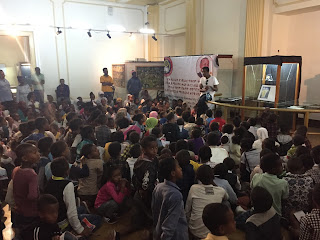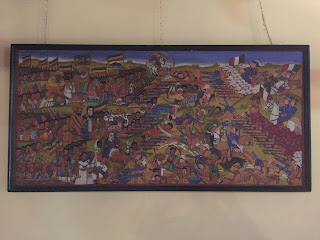The year is almost at an end and Christmas is nearly upon us. Unless something notable happens between now and this upcoming Friday (when we leave on a ten-day trip to Egypt), this will probably be the last blog post of 2019. It's been a year that has seen us move to a new city, country and continent, but I'll dispense with the "Year in Review" analysis and focus on the last couple of weeks. Namely, how my daughter and I were able to successfully visit one of the Ethiopia's finest museums on Saturday after having been turned away at the gate the previous Sunday due to an event that was taking place at Addis Ababa University አዲስ አበባ ዩኒቨርሲቲ, where the Ethnological Museum (aka the IES Ethnographic Museum and Library) ብሄራዊ ሙዚየም is located.
On Saturday, as we did last Sunday, we parked our car at the U.S. Embassy and walked the 1.4 kilometers (0.9 miles) down Algeria Street to the main gate of the university, losing 67 meters (220 feet) of elevation in the process. Across the road from where we parked, as at many U.S. diplomatic facilities around the world, are businesses that "assist" applicants in applying for visas to travel to the United States. These establishments coach their customers on what to say during visa interviews, and provide fraudulent documents for suitable fees:
A typical side street:
The main gate of the university:
The awarding of this year's Nobel Peace Prize to the Prime Minister of Ethiopia, Abiy Ahmed አህመድ አሊ, has naturally been a major news story (and a source of pride) in this country:
It's a 400 meter-long stroll from the main gate through the American-style campus grounds to the museum entrance:
Just in front of the museum is this interesting spiral staircase, erected by the conquering Italians in 1935. Each step represented each year Benito Mussolini had been in power, starting with the March on Rome in 1922. However, a small Lion of Judah statue, a symbol of the Ethiopian monarchy and of the defeat of the Italians in 1941, now sits on the top step:
The museum is housed in the former palace of Emperor Haile Selassie ቀዳማዊ ኃይለ ሥላሴ:
There's a small exhibit on the history of the building in the entrance hall:
Haile Selassie survived this coup attempt, but his ouster on September 12, 1974 would result in hardship and suffering for millions of Ethiopians in the years following:
Amber thought this was a seismometer at first, but was very surprised to learn it was an Amharic typewriter!:
A couple of figurines getting it on. As I'm learning from work, this society isn't as conservative as initially assumed:
The main exhibits begin on the 2nd floor, which is organized thematically around the life cycle, starting with Childhood and ending, of course, with Death and beyond. The first section includes several examples of folk tales told to children as part of their moral education:
An example of a very small Ethiopian Orthodox Church that would be found in small rural villages:
In between childhood and death are exhibits on body culture, handicrafts, traditional medicine, war and so on:
Coffee ceremony accoutrements:
Examples of beehives used by beekeepers:
Death and Beyond:
Several busloads of schoolchildren arrived at the museum soon after we did. The kids were naturally excited to see my daughter and me (as well as several other foreigners visiting at the same time), but compared to kids of a similar age in Taiwan, they were much more respectful. Amber didn't appreciate the attention, but I enjoyed exchanging many greetings and shaking a lot of small hands. One little girl, in particular, spoke English very well, and told me she was proud to be learning more about her country. In the photo below, (some of) the children are listening to an explanation of the PM's Nobel Peace Prize:
A glimpse of the Grand Anwar Mosque, Addis Ababa's largest, from a second-floor window:
Haile Selassie's bedroom:
The emperor's changing room, which gifts from foreign leaders displayed on shelves:
The imperial commode. According to my Lonely Planet guide, the mirror in this bathroom supposedly has a bullet hole from the 1960 coup attempt, but neither Amber or I could see it:
The third (and top) floor of the museum is divided into two sections. The smaller area is devoted to traditional Ethiopian musical instruments:
A painting depicting the battle at Adwa አድዋ...:
...with a closeup of whom I assume to be Emperor Menelik II ዳግማዊ ምኒልክ leading the Ethiopian soldiers:
The larger area is devoted to Ethiopian religious art, featuring many crosses, diptychs, triptychs and icons:
A selfie taken on our way downstairs to the exit. The lion in the background is desperately trying to get away from us:
Back outside, a group of French-speaking travel hipsters takes a break on the spiral staircase. While there were no signs prohibiting the doing of such, it came across as disrespectful in my aging eyes:
A close-up of the Lion of Judah statue:
Although the Ethnological Museum shares much in common with other museums I've been so far in Ethiopia (dark interiors, lack of sufficient labeling and so on), it does a better job than the others in portraying this country's fascinating culture(s) and history, and was definitely worth the effort it took Amber and I to finally make it inside.
I like to think I've adapted fairly quickly to the traffic chaos that is driving in Addis. One thing I've learned is to give overburdened vehicles like this one a lot of leeway as they barrel their way through the roundabouts of the capital city:
Going back to the previous Sunday (when we couldn't get inside the campus to visit the museum), with nothing to do for the rest of what turned out to be a gloriously sunny afternoon, I went for a long walk. While there aren't any diplomatic facilities in my immediate neighborhood (unless you count the house where I live!), the districts surrounding us are chock full of embassies and residences. Within walking distance of our home (note that my definition of "within walking distance" might be broader than most people's) can be found diplomatic facilities of one type or another belonging to the following countries: Angola, Austria, Azerbaijan, Bangladesh, Canada, DR Congo, Finland, the Gambia, Indonesia, South Korea, Mauritania, Mozambique, Norway, Qatar, South Africa, Sudan, Togo, the Vatican and Zambia. And those are just the ones I'm aware of:
But there's only one country that has given Ethiopia legitimate Pizza Hut outlets:
The massive African Union Commission complex is also close by, towering over the neighboring shantytowns:
One thing I haven't figured out yet re my Canon camera is how to take decent photographs once the sun has set. Dawn and dusk shots, like this one taken from my balcony around 1800 hours on a Sunday evening (notice all the hawks circling about overhead) are usually acceptable...:
...but darker scenes almost always turn out blurry, unless I use the flash. The results with the latter leave much to be desired:
A typical Sunday afternoon street scene in my neighborhood
A memorial on the embassy grounds to the sixteen people who died in a plane crash in Gambela in August 1989. The most prominent victim was Texas Democratic congressman Mickey Leland.



















































No comments:
Post a Comment